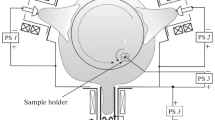Conclusions
-
1.
A number of Pt, Pd, Ru, Rh, Os, Ir, Ag, W, Mo, Ni, Ni+30% Re, Re, and Re+30% Ni base powder metallurgy alloys containing a beryllate active phase have been developed. Such alloys exhibit, under intense electron bombardment conditions, high and stable coefficients of secondary electron emission and low, controllable levels of thermionic emission.
-
2.
Effective high-temperature thermionic emitters based on tungsten and rhenium with additions of yttrium and gadolinium tetraborides have been formulated. These are distinguished from W+Y2O3 type emitters by simplicity of aging, absence of sparking and breakdowns, and stability of operation.
-
3.
Using the powder metallurgy technique, thin-walled cylindrical tungsten-tantalum alloy cathodes were produced characterized by satisfactory shape stability and long useful life at high temperatures (1700–1900°C)
-
4.
The use of powder metallurgy billets produced from powders containing intermetallic compounds of platinum and palladium with barium reduces by two-thirds labor in the manufacture of platinum-barium and palladium-barium alloy strip. The method lends itself to the manufacture of strip in nickel alloys of increased alkaline-earth metal content.
Similar content being viewed by others
Literature cited
S. I. Faifer, S. M. Zhdanov, A. P. Korzhavyi, et al., Summaries of Papers to the 14th All-Union Conference on Emission Electronics [in Russian], Sect. 3, Fan, Uzb. SSR, Tashkent (1970), p. 41.
G. V. Samsonov, Yu. K. Lapshov, I. A. Podchernyaeva, et al., Poroshkovaya Met., No. 6, 13 (1966).
D. Langmuir and L. Malter, Res. Div. R.C.A. (1942).
B. Ch. Dyubua, O. K. Kultashev, and L. V. Gorshkov, Fiz. Tverd. Tela,8, No. 4 (1966).
B. Ch. Dyubua, L. A. Ermolaev, N. P. Esaulov, et al., Radiotekhn. i Élektron.,12, No. 8 (1967).
B. Ch. Dyubua, N. T. Ostroverkhov, et al., Élektronnaya Tekhn., Ser. 1, Élektron. SVCh, No. 6 (1968).
Transactions of the Fifth Scientific-Technical Conference on Thermionic Cathodes, Élektronnaya Tekhn., Ser. 1, Élektron. SVCh, No. 10 (1968).
H. Schulz, K. Ritapal, et al., Z. Anorg. Allgem. Chem.,357, 299 (1968).
W. Bronger and W. Klemm, Z. Anorg. Allgem. Chem.,319, 58 (1962).
Author information
Authors and Affiliations
Additional information
V. F. Artsykhovich, B. A. Yaremchuk, and L. A. Chapaikina also took part in the investigation.
Translated from Poroshkovaya Metallurgiya, No. 2 (122), pp. 101–107, February, 1973.
Rights and permissions
About this article
Cite this article
Faifer, S.I., Zhdanov, S.M., Busol, F.I. et al. Sintered cathode materials for electric vacuum devices. Powder Metall Met Ceram 12, 171–176 (1973). https://doi.org/10.1007/BF00807785
Received:
Issue Date:
DOI: https://doi.org/10.1007/BF00807785




